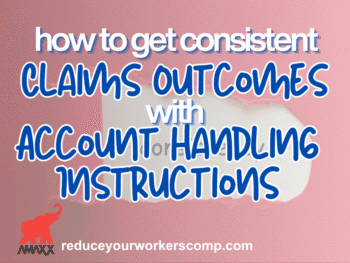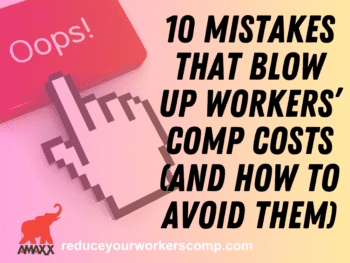A lot of employers strive to maintain a safer, more productive workplace for their employees. Every business would love to reduce costs and increase profit margins. The cost of claims can account for a big chunk of money losses, especially for the self-insured or self-administered employer.
So how do you get started? Where do you start, or better yet when do you start? The answer is RIGHT NOW, and here is how:(WCxKit)
1. Know where your risk lies
Observe your workplace. Go through department statistics and see how they compare to each other regarding losses. Perhaps 75 percent of your injuries occur in the shipping department. Go down there and talk with the supervisor. Find out what the issues are and why they think injuries are happening. Then work together to solve the problem.
Observe your workplace. Go through department statistics and see how they compare to each other regarding losses. Perhaps 75 percent of your injuries occur in the shipping department. Go down there and talk with the supervisor. Find out what the issues are and why they think injuries are happening. Then work together to solve the problem.
Another helpful thing to look at is your loss run. Talk to your carrier or adjuster and see if they notice any trends in injuries. Which people are getting injured? Maybe newer hires account for a lot of injuries. This may show that a focus needs to be directed toward training and safety right from day one of employment.
Look at your business. What do you do? What are the risks involved? You could have risks from several areas, stretching from workers comp, to automotive issues with your fleet and the drivers, to liability risk from customers in your store. Break it down and track your statistics. Identify issues. Work on ways you can reduce your injuries or occurrences from happening in the first place.
2. Plan your attack
OK, so you have identified a few areas where you could improve on reducing some injuries or claims reports. So, what do you do to fix it? Planning is important, but the most important thing is to start, even if that is with very small steps.
OK, so you have identified a few areas where you could improve on reducing some injuries or claims reports. So, what do you do to fix it? Planning is important, but the most important thing is to start, even if that is with very small steps.
The answer lies in the resources you have all around you. The first step is to talk to your carrier. Chances are the carrier has loss prevention specialists ready to help you work with what needs to be fixed. Ergonomic professionals can be brought in to address workstations and to suggest solutions to reduce exposure. Utilize your medical clinic contacts to see if occupational physicians can watch employees working. They can then identify potential issues with certain movements or repetitive-motion injuries. Utilize your local counsel by having them come in to explain the risks and costs associated with potential serious injuries, automotive accidents, failure to drug test your employees, etc. Any or all of these will help you reach your goal of reducing risk exposure.
3. Implement your solution
Now, if you identified what needs to be fixed, and how it should be fixed, now it is time to fix it. Get rid of old equipment and bring in new equipment with better safety features. Newer equipment costs less to maintain and repair and is quicker to operate. Most new machines use less energy than old ones, reducing utility bills and creating worker ease of operation. Get some padding on the floor for workers to stand at their workstations (also known as “fatigue mats.”) This reduces strain on feet and legs, and reduces body fatigue, potentially making employees more productive after long hours at work.
Whatever the fix may be, get it done. Out with the old — in with the new.
4. Measure your success statistics
So now your new equipment is installed and in place. Now it is time to measure your reductions. Take a two, four, and six month stretch and measure your numbers. Do you see a drop in claim activity? Or, did claims increase, meaning your plan backfired? You have to see how you did, and most importantly you have to give it time. Change is disruptive to employees, but they do get used to it. Give it time, and measure your numbers post-change against the ones you first noticed back when you were figuring out where your risk was coming from. Measure lost-time days, and post your progess at the front entrance.
5. Get feedback from your workers
After all you did, you left out the most important thing: To talk to your staff of workers about the changes. How do they feel it impacted their workday? Were the changes helpful, or did they hurt production? How do they feel at the end of the day? Do they feel less sore or are the new workstations worse than the old ones?
Ask as many questions as you can. This makes your staff feel that their input is important, and taken in to account. After all who better to talk to about the implemented changes than those who are directly affected day after day?(WCxKit)
A supervisor once said, “It is hard to fully embrace change. To make things easier, you have to ‘lean’ into it a bit at a time until you have accepted the entire package of change.” This is true on many levels. Even though it is hard work to find out what your risks are, discover how to attack them, implement changes, measure success, and get worker feedback, in the end it will be worth it. Lean in to the task. Do not try to tackle it all at once. As I have always said, "Don't eat elephant in one bite."
Author Rebecca Shafer, JD, President of Amaxx Risk Solutions, Inc. is a national expert in the field of workers compensation. She is a writer, speaker, and website publisher. Her expertise is working with employers to reduce workers compensation costs, and her clients include airlines, healthcare, printing, publishing, pharmaceuticals, retail, hospitality, and manufacturing. See www.LowerWC.com for more information. Contact: RShafer@ReduceYourWorkersComp.com.
LEARN ABOUT OUR BOOK: http://www.wcmanual.com
WORK COMP CALCULATOR: http://www.LowerWC.com/calculator.php
SUBSCRIBE: Workers Comp Resource Center Newsletter
Do not use this information without independent verification. All state laws vary. You should consult with your insurance broker or agent about workers comp issues.
©2011 Amaxx Risk Solutions, Inc. All rights reserved under International Copyright Law. If you would like permission to reprint this material, contact Info@ReduceYourWorkersComp.com.














